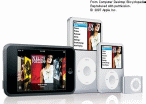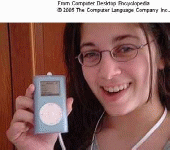Introduction
With the availability of a large number of products that serve to satisfy the same need, it becomes very had for the consumer to make a choice as to which product to by and which one to avoid. This is why the marketers have to come in to find out ways of to changing the consumer attitudes towards their brands in order for them to gain more customers.
They have to come up with the marketing strategies that enable them to win the competition. These strategies give shape to the consumer behavior. Consumer behavior can be defined as “actions undertaken by people (consumers) that involve the satisfaction of wants and needs…such actions often, but not always, involve the acquisition of goods and servcies through markets” Economic Glossary, 2011).
The focus of this paper is on the consumer behavior in regard to the Apple’s iPod. Introduced in 1971 by Steve Jacobs, beginning from that time, the company has turned out to be a brand to reckon with. Apple’s customers are very loyal to the company’s brand. Among the most innovative products that have been brought to the market is the iPod (VERTGO Team, 2011).
This product is the market leader “in the product category of portable music players and has created a niche for itself” (Weisbein, 2008). A large number of people have been attracted by the iPod’s fashionable appearance and ease of use and there has been no defined specific target market for the product.
However, the young people play a great part in the expansion of the iPod market since they have given the product the representation of being stylish and youthful. This paper seeks to explain how marketers try to generate positive attitudes toward the iPod product.
In order to achieve this, a behavioral analysis is carried out in which the role of individuals factors such as motivation and values, learning and perception are considered. Other individual actors considered are; individual decision making process, attitudes and personality. These are looked at in relation to how the Apple Company is able to develop its marketing strategies for the iPod product through understanding the consumer behavior.
Perception
There are various individual factors that are linked to the iPod which include the
sensory receptors such as hearing, vision and touch. The Apple Company has used these to influence the consumer behavior. The iPod product can be seen as being a simple device and yet fashionable, stylish and attractive (See images below).



The wheel, which is found below the screen, that is used for controls, is “an innovative technology never seen before” (iBummed.com,. 2011, p.1). As it can be seen in the photographs above, the screen of the iPod is big, making it possible for the users to be able to see the functions such as the song list.
According to Varian (2007), “the material used to build the iPod are of high quality and smooth to touch” (Varian, 2007, p.1). The iPod’s wheel has “touch sensing ability for voice controls” (iBammed.com, 2011, p.1). In addition, the iPod is a digital musical player that plays the entire much loved tracks of the owners.
There is use of “behavioral pricing” because the iPod is of high quality, thus the price is higher than that charged by the competitors. It is pointed out that “it is normally hedonic consumption as mostly all the sensory organs are associated with it and the purchase decision for specifically iPod can not be justified” (iBammed.com, 2011, p.1).
The main target of the advertisement campaigns is the young audience and this is for the reason that there is a higher likelihood that young consumers will use this product and go on remaining loyal to the brand for a longer time. Another reason is that the younger consumers will be attracted to the fashionable appearance and offering it “a young and trendy look” (iBammed.com, 2011).
Learning and Memory
Positive reinforcement serves a significant role as the iPod consumers become members of a community and develops a sense of belonging to this community. In addition, the iPod consumers are considered to be young, fashionable, modish, and attractive by other people in the society which assist in boosting these consumers’ morale and image. Also, the consumer can listen to his or her much loved music “on the go” and this is an additional benefit.
In addition, “there is a form of observational learning or vicarious learning as many people buy the iPod because they see many famous celebrities, models, actors, loved ones owning and sharing their playlists and songs with each other” (iBummed.com, 2011, p.1). Moreover, it is observed that a large number of designers are coming up with “luxury accessories” for the iPod with an intention of personalizing it” (Costello, 2008).
Motivation and Values
The main objective of the motivation process is “the need to listen to music while on the move and the need to be trendy, young and belonging to the iPod community” (iBammed.com, 2011, p.1). The stimulating factor is the pressure that is brought about by the people surrounding the consumer which makes him to be exposed to the iPod.
The want is the eventual buying of the iPod at a time the consumer realizes satisfaction as he has attained his goal. The measurement of the motivational power can be carried out by the “expectancy theory” since the consumer expects this product to play his much love music. The iPod is entirely linked to “hedonic needs since it is a need for excitement” (iBammed.com, 2011, p.1).
In addition, it as well portrays the need for affiliation since those who own the iPod can engage in the exchanging of the playlists, music and iPod amongst themselves, forming an iPod community. More so, it can portray the need for achievement in part since the Apple Company is regarded as a luxury brand and the iPod is regarded as a “luxury technological product” (iBummed.com, 2011, p.1).
Furthermore, the iPod is identified with two brands in the Maslow’s hierarchy and these are belongingness and self-actualization. There are reasons for that. One of the reasons is that those who own the iPod are majorly the people who engage in travelling and have a desire to listen to music they love most as being their hobby or as a source of entertainment.
In addition, the belongingness is linked to the iPod since it has formed up a community and each person that possesses it is part of that community. It is also pointed out that particular type of channel is brought about in the community referred to as podcast that has “news, favorite TV shows, music albums, talk shows etc, relayed on the portable music player, primarily iPod” (PCMag, 2008, p.1).
The iPod is a “high involvement” product because various choices of iPods are available to the consumers and this depends on the needs they have. Adding to this, the consumers have a great relationship with their iPods they have and they have the “fondness to accessorize it in accordance with their needs” (iBammed.com, 2011, p.1).
The number of songs an iPod can carry is determined by the capacity and this is a significant decision since the price is higher than the one charged on the similar products brought to the market by the competitors. However, the iPod can not be regarded as a “materialistic” device and this is for the reason that it is bought with an intention of wanting to listen to music. Moreover, the iPod is used for personal satisfaction as well as for entertainment. Thus, there is a high likelihood that the non-materialistic people will buy it.
Personality and lifestyles
The research that has been carried out by Apple has assisted in understanding the kind of personality the iPod instills in the minds of the people. The focus of the iPod’s personality is on “simplicity, emotions, imagination, lifestyle, innovation and passion” (iBammed.com, 2011, p.1).
According to the analysis carried out by iBammed.com (2011), it was established that the iPod would be associated with “individuality or Social Acceptance in the Dichter’s Motives of Consumption” (iBammed.com, 2011, p.1). The playlists of their own kind together with selected “accessorizing iPods” indicate that individuality as well as the need for belonging to the iPod community could exhibit “social acceptance” (iBammed.com, 2011).
Additional personality characteristics analysis assists “to define BrandAsset Valuator Archetypes devised by Young and Rubicam” (iBammed.com, 2011, p.1). The iPod do have two main archetypes; “being Queen and Actress” (iBammed.com, 2011). ‘Queen being’ possesses characteristics of “relaxing, comforting, and sociable which are similar to that of iPod that it helps relaxing, comforting, and is very sociable device” (iBammed.com, 2011, p.1). On the other hand, ‘Actress’ possesses traits of “glamorous, dramatic, and involved and similarly users of iPod are highly involved with the product, and consider it as a trend setter” (iBammed.com, 2011, p.1).
The kind of lifestyle which the iPod consumers have is an immense one. People who engage in travelling for various reasons are all included since a larger number of them have the fondness of listening to the music they love the most in the course of carrying out their activities. Even those who sit at home and those who don’t want to move around carrying their CD’s prefer buying the iPod because it is convenient to carry since it fits well in the pocket and has a complete music library that one may desire to have.
Attitudes
The attitude is possibly formed as a consequence of a negative or positive personal experience. According to Oskamp and Schultz (2005), “maybe outside influences of other individuals persuaded the consumer’s opinion of a product or service…..attitudes are relatively enduring” (Oskamp and Schultz, 2005, p.8). Attitudes are learned tendency to go ahead in line with or against a given object. In regard to marketing, “an attitude is the filter to which every product and service is scrutinized” (Dean, 2010, p1).
Among the most recognized defined functions presented by Katz is the utilitarian function. This function is formed on the basis of the ethical theory of utilitarianism, “where as an individual will make decisions based entirely on producing the greatest amount of happiness as a whole” (Sidgwick, 1907, p.33). The attitude of the consumer is apparently formed on the basis of a utility function at a time the decision revolves around the quantity of happiness or suffering it brings (rewards or punishment).
The iPod product can be linked to the “Utilitarian function” and this is for the reason that it has punishments and rewards involved. “The reward of owning are listening to quality music whenever and wherever, storing and possessing huge music collection in a device that can fit in to one’s pocket, and to belong to a community” (iBammed.com, 2011, p1). On the other hand, the punishments for not having an iPod may involve “alienation, discomfort and maybe purchasing a competitor brand” (iBammed.com, 2011, p1).
Considering the Apple iPod in relation to the ABC model, because the iPod is a product of “high involvement” the “standard learning” may apply to it. “According to which initially the consumer has the phase of cognition where he has a belief about the iPod”( iBammed.com, 2011, p1). This belief in turn is changed to the feeling the consumer sets up for the iPod and he eventually makes a decision to buy it or decides to take any action concerning the iPod.
Individual Decision Making Process
The “individual decision making process” can either be collectivistic or individualistic. In the case where this process is individualistic, it is greatly “experiential perspective” since the individual purchases the iPod purely for the reason that the product is appealing. This process encompasses problem solving as the iPod is a product of “high involvement” and a decision to buy it consists of particular risks.
It is pointed out that the decision to buy the iPod has an ‘Opportunity Recognition’ as the Actual state “remains the same, where the consumer is using the CD player and buying several CD’s, but the Ideal state is uplifted where the consumer can carry all his songs in one device which can fit in the pocket” (iBammed.com, 2011, p.1).
Comprehensive external search is carried out by visiting friends and family, company website, and looking at the reviews and blogs. In addition, a lot o search is carried out before purchasing the product because it is a “high involvement” product and important information is required to make the buying decision. The single perceived risk which is involved is the price since the iPod is a very expensive device in comparison to the competitors’ products.
The consumers who form the “Apple Community” do not just go for any alternatives buy they rather purchase it right away. Those consumers who are not part of the Apple Community have very limited alternatives from the competitors and the only existing competitor that may “match with iPod is the Microsoft Zune” (iBammed.com, 2011, p.1).
In view of the fact that the iPod has created a unique niche and is on the highest level of the product category, “it dominates the market of portable music players and according to the Zipf’s Law; it is 50 percent more profitable when compared to its nearest competitor that is Microsoft Zune” (iBammed.com, 2011, p.1).
At a time the consumers want to buy an iPod, they can approach a group of family members or friends. The “basic reference group will be the family members and this is followed by friends and colleagues” (iBammed.com, 2011, p.1). A large number of offices do have a culture of engaging in the sharing of the iPod playlists or even iPods. In addition, the consumers who have similar outdoor activity taste and have fondness for music among other things will associate with and look for advice from amongst them.
Before buying, the consumer’s decision to buy can be influenced by the opinion leaders. In addition, in the household decision making process, in most cases, “the young people are the ones who come up with decisions first for purchasing the iPod because they are ‘techno-savvy’ and other family members will follow this decision later on” (iBammed.com, 2011, p.1).
Moreover, peer pressure can as well have a great influence on the decision since the iPod is regarded as a fashion setter and if a person does not have one, he or she feels out of the place or not being part of his or her own group.
Conclusion
The Apple iPod is a market leader and a large number of consumers are always willing to buy even if it is obtained at a higher price than similar products offered by the competitors on the market. The Apple Company has been able to instill a positive attitude in the consumers’ mind. It has been able to change the consumer behavior and many of them are willing to belong to the “iPod Community”.
This has been realized through understanding the consumer behavior and applying the appropriate models in setting up the successful marketing strategy. However, there is need for the company to continue understanding the consumer behavior and coming up with new strategies to deal with the ever increasing competition.
References
Costello, S, 2008. The Onion’s Celebrity iPod Interviews. Web.
Dean, G., 2010. Understanding consumer attitudes. Web.
Economic Glossary, 2011. Economic definition of consumer behavior. Web.
iBammed.com, 2011. Consumer behavior report – Apple iPod. Web.
Oskamp, S. and Schultz, W., 2005. Attitudes and opinions. New Jersey: Lawrence Erlbaum Associates.
PCMag, 2008. Definition of podcast. Web.
Sidgwick, H., 1907. Methods of ethics. London: Macmillan and Company.
Varian, H. R., 2007. An iPod Has Global Value. Ask the Countries That Make It. Web.
VERTGO Team, (2011). Apple marketing strategy. Web.
Weisbein, J. 2008. The iPod success: Thank the marketing department. Web.